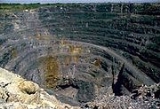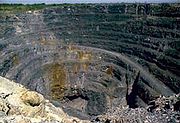
Kidd creek
Encyclopedia
Kidd Mine an underground base metal
mine in the city of Timmins
, Ontario
, Canada. It is owned and operated by Xstrata
Copper, following the August 2006 takeover of Falconbridge Ltd.
Ore
from the Kidd mine is processed at the Kidd Metallurgical Site
, located 27 km (16.8 mi) southeast of the mine. Kidd Mine is the world's deepest copper/zinc mine.
 The Kidd deposit is one of the largest volcanogenic massive sulfide ore deposit
The Kidd deposit is one of the largest volcanogenic massive sulfide ore deposit
s in the world, and one of the world's largest base metal deposts. It lies within in the Abitibi greenstone belt
.
and backfill systems to the new sections of the mine.
mine in the world. The maximum depth of almost 10000 feet (3,048 m) and its northerly latitude mean that the bottom of the mine is the closest accessible point to the centre of the Earth. Although some South African mines, such as TauTau are deeper, the greater equatorial radius of the earth mean that they are further from the centre.
Base metal
In chemistry, the term base metal is used informally to refer to a metal that oxidizes or corrodes relatively easily, and reacts variably with diluted hydrochloric acid to form hydrogen. Examples include iron, nickel, lead and zinc...
mine in the city of Timmins
Timmins, Ontario
Timmins is a city in northeastern Ontario, Canada on the Mattagami River. At the time of the Canada 2006 Census, Timmins' population was 42,997...
, Ontario
Ontario
Ontario is a province of Canada, located in east-central Canada. It is Canada's most populous province and second largest in total area. It is home to the nation's most populous city, Toronto, and the nation's capital, Ottawa....
, Canada. It is owned and operated by Xstrata
Xstrata
Xstrata plc is a global mining company headquartered in Zug, Switzerland and with its registered office in London, United Kingdom. It is a major producer of coal , copper, nickel, primary vanadium and zinc and the world's largest producer of ferrochrome...
Copper, following the August 2006 takeover of Falconbridge Ltd.
Falconbridge Ltd.
Falconbridge Limited was a Toronto, Ontario-based natural resources company with operations in 18 countries, involved in the exploration, mining, processing, and marketing of metal and mineral products, including nickel, copper, cobalt, and platinum. It was listed on the TSX and NYSE , and had...
Ore
Ore
An ore is a type of rock that contains minerals with important elements including metals. The ores are extracted through mining; these are then refined to extract the valuable element....
from the Kidd mine is processed at the Kidd Metallurgical Site
Kidd Metallurgical Site
The Kidd Metallurgical Site is a metallurgical facility in Timmins, Ontario, Canada. It is owned and operated by Xstrata Copper, following their 2006 takeover of Falconbridge Ltd...
, located 27 km (16.8 mi) southeast of the mine. Kidd Mine is the world's deepest copper/zinc mine.
History
The ore deposit at Kidd Mine was discovered in 1964, and began operation in 1966, as an open pit mine and eventually evolved into an underground mine. The mine produces copper, zinc, and several other metals.Geology

Volcanogenic massive sulfide ore deposit
Volcanogenic massive sulfide ore deposits are a type of metal sulfide ore deposit, mainly Cu-Zn-Pb which are associated with and created by volcanic-associated hydrothermal events in submarine environments....
s in the world, and one of the world's largest base metal deposts. It lies within in the Abitibi greenstone belt
Abitibi greenstone belt
The Abitibi greenstone belt is a 2,800-2,600 million year old greenstone belt that spans across the Ontario-Quebec border in Canada. It is mostly made of volcanic rocks, but also includes ultramafic rocks, mafic intrusions, granitoid rocks, and early and middle Precambrian sediments.-Geographical...
.
Current operation
Kidd Mine and Met Site collectively employ 2,200 employees and contractors, and in 2008 committed to investing $120 million to extend the production to 2017, and deepen the mine to 9600 feet (2,926.1 m), from its current depth of 9100 feet (2,773.7 m). The investment would add 3.4 million tonnes of ore into the mine plan. The expansion will include the development of three additional production levels and deepening the ramp from the 9100 level to the 9600 level, where the loading pocket is located. There will be an extension of the ventilationUnderground mine ventilation
Underground mine ventilation provides a flow of air to the underground workings of a mine of sufficient volume to dilute and remove noxious gases . The source of these gases are equipment that runs on diesel engines, blasting with explosives, and the orebody itself...
and backfill systems to the new sections of the mine.
Depth
The mine is the deepest base metalBase metal
In chemistry, the term base metal is used informally to refer to a metal that oxidizes or corrodes relatively easily, and reacts variably with diluted hydrochloric acid to form hydrogen. Examples include iron, nickel, lead and zinc...
mine in the world. The maximum depth of almost 10000 feet (3,048 m) and its northerly latitude mean that the bottom of the mine is the closest accessible point to the centre of the Earth. Although some South African mines, such as TauTau are deeper, the greater equatorial radius of the earth mean that they are further from the centre.

